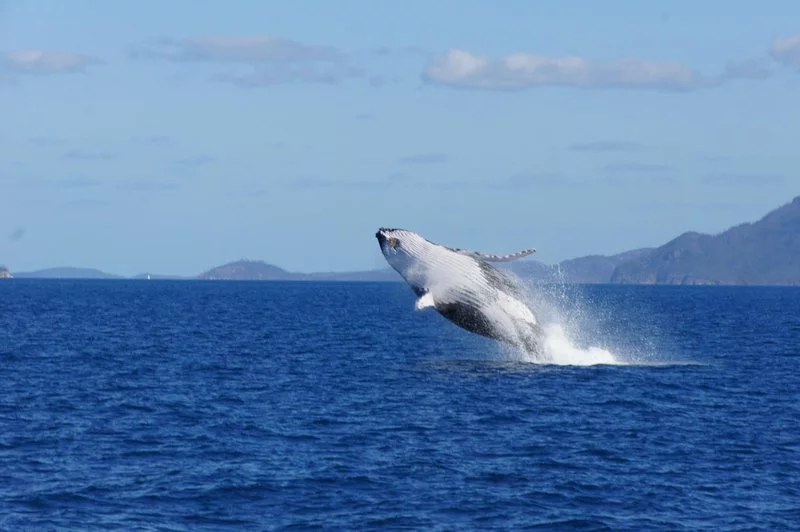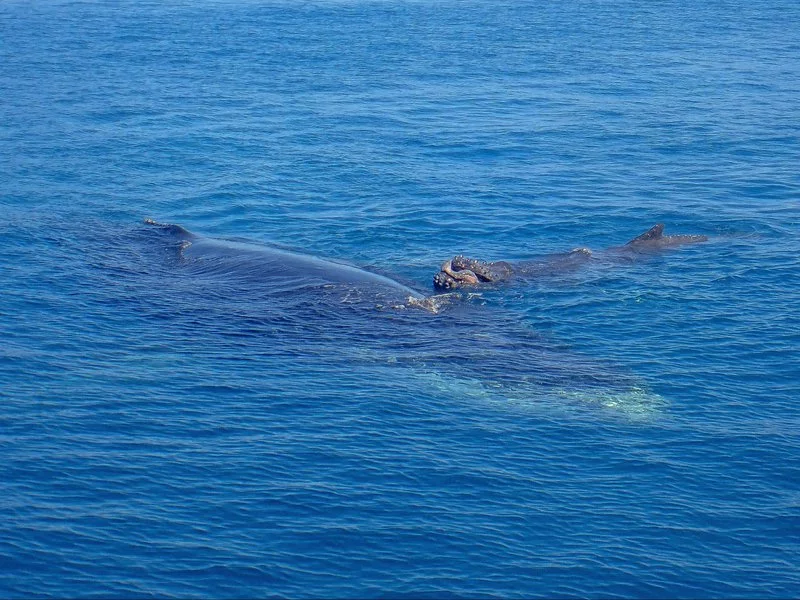Humpback Whales
Humpback whales are part of a group of marine mammals known as cetaceans. This group includes whales, dolphins and porpoises. The humpback can be found in all of the world's oceans from the frigid antarctic and arctic waters at the poles to the warm tropical waters around northern Australia. They can reach lengths of up to 18 meters and weigh a massive 30-50 tonnes when fully grown. These gentle giants don’t let their size get in the way though, they love to play around, leaping full bodied out of the water and splashing back down. This breaching behaviour is what humpbacks are renowned for and the show captivates whale watchers world wide.

The humpbacks are a member of the baleen whale subgroup. Baleen is made of keratin which is the same substance which human fingernails and hair are made from, in whales this is formed into bristle like structures which are arranged in plates along the upper jaw. The whales use this baleen in a filter feeding system. They scoop large amounts of water into their open mouths then they close it partly while forcing the water back out through the baleen plates while any food gets trapped by the plates and swallowed by the whale. Baleen whales are carnivorous so the food they filter from the water includes things like krill, small fish, copepods and the odd unlucky bird who is feeding on the same shoal as the whale.
Their food source is a big contributor to the migratory behaviour of humpbacks. Krill makes up the bulk of their diet and prime waters for these tiny crustaceans are the cold waters around the polls, so this is where humpbacks spend a lot of their time. However freezing cold waters are not ideal conditions for breeding and calving, warm shallow waters are better suited for this. So to get around this humpbacks and many other species of whales migrate between feeding and breeding/calving grounds. The humpbacks have one of the longest migrations of any mammal in the ocean or on land, on average they can travel 5000km a year.
In the southern hemisphere humpback whale populations spend the warm summer months in the southern ocean down near Antarctica feeding on the abundant supply of krill. Then in autumn they begin their annual migration north to the warmer tropical waters. It is here that they breed and give birth to their calves.
Here in the Whitsundays we are lucky enough to have the company of humpback whales in our winter months. The calm and protected waters around the islands are the perfect environment for the whales to care for and teach their newborns important skills for survival. This is the perfect opportunity for us to see these gentle giants in their natural habitat doing what nature intended while also being treated to the spectacular physical displays of breaching, tail and fin slapping that the whales put on.

The physical displays of the humpback whales are not the only thing that they are known for, another thing that they are famous for are their comely and hauntingly beautiful songs. Whales have the ability to vocalise which is an important form of communication for them. Male humpbacks use these vocalisations to perform “songs” which are believed to be for the purpose of attracting a mate. These songs can even be heard by humans. If you are lucky enough to be snorkelling around the Whitsundays during whale season, swim under the water about a meter or so and listen carefully, you may be able to hear the whales serenading each other.
The history of human interactions with humpbacks has not always been so positive. In the past these whales were hunted almost to extinction for their meat, bones, hide and oils. In Australia the whaling of humpbacks was shut down in 1963 and they were a globally protected species by 1965, and in 1979 Australia ended all whaling in Australian waters. Since the bans on whaling and international policies for the protection of whales, humpback populations overall have been recovering and this species has moved from vulnerable to least concern on the IUCN red list. However we still have a long way to go in the protection of whales to keep these magnificent creatures around in their oceans for years to come.



